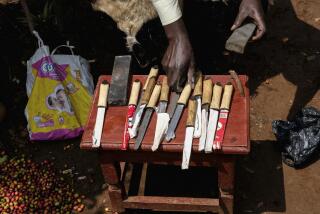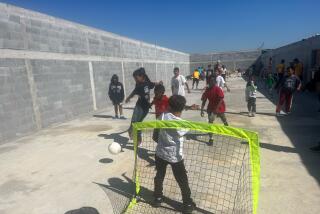WOMEN AND POWER : Childhood : Tougher for Girls From the Word ‘Go’ : They often start on the lowest rungs of the social ladder, lacking adequate food, education and medical care. But help is on the way from relief agencies.
- Share via
The 9-year-old girl was lying in a pool of blood at a Somali refugee camp, crying and pleading for help.
“I thought, ‘What has happened to this girl” recalled Dr. Milton Amayun. He picked her up, carried her to the camp clinic and examined her. And then he vomited.
“It’s probably the most barbaric, the most shocking condition of any girl child I have seen in my whole life,” said Amayun, the director of international health programs for World Vision, a Christian relief and development agency headquartered in Monrovia.
The girl had been subjected to a common African rite--female circumcision, or the cutting away of genital tissue, usually under the crudest of circumstances. In this case, a kitchen knife had been used. There was no sterilization, no anesthetic. The edges of the raw wound had been tied together with thorns.
Misery abounds in the poverty zones where Amayun and World Vision work. But as Amayun so vividly remembers from his 1981 visit to the Somali camp, girls experience their own particularly harsh version of it.
Confined by culture and tradition to the lowest rungs of the social ladder, young females are denied food, education and medical care that go to males. They are forced into prostitution, childhood marriages and premature motherhood. They are mutilated and left to die as infants. In some countries, female fetuses are aborted at a greater rate than male fetuses.
Statistics tell the story:
* Estimates cited by the U.N. Development Program indicate that as many as 100 million women are “missing” in Third World countries--that is, there are 100 million fewer women in those regions than should be expected according to normal global mortality patterns. The disparity is attributed to high maternal mortality, infanticide and “nutritional neglect of the girl-child.”
* The World Health Organization estimates that more than 80 million African girls have undergone female circumcision.
* In South Asia, female literacy rates are only about 50% those of males. Even in industrialized nations, studies show that boys continue to be favored over girls, albeit in more subtle ways.
* Data from Thailand indicates there are 800,000 girl prostitutes in that country under the age of 16, according to the U.N. Children’s Fund (UNICEF). Increasingly, those concerned with the Third World are finding it impossible to ignore such figures. “This has gotten people’s attention, finally,” observed World Vision President Robert A. Seiple during an interview in his Monrovia office.
As a result, workers at World Vision and other relief agencies, such as UNICEF, are stepping up efforts to improve the lives of “girl children.”
The reasons are both humanistic and pragmatic. If you improve the lot of girls, the rationale goes, you improve the lot of the women and mothers they become, and therefore their families and communities.
World Vision--which was founded in 1950 to help care for Korean War orphans and now operates in 94 nations--adopted its “Girl Child Initiative” last year to heighten staff awareness of girls’ needs.
The initiative is not so much a dramatic new project as “a mind-set,” Seiple explained. It also reflects a broader shift in thinking.
“It used to be, we’d go in, apolitically, and feed hungry kids,” Seiple continued. “Those days are over. . . . As soon as the famine is over, the girl children are still denigrated, still marginalized.”
Now, through its existing projects, World Vision is trying to counter some of the cultural weights that keep girls at the bottom of the economic and social heap.
For instance, the agency is deliberately favoring girls in sponsorship programs that assist children with textbook and other school costs. Because families value boys more, they are more apt to scrape together the money to send them to school, leaving the girls in greater need of outside help.
Similarly, Amayun said that World Vision and UNICEF have suggested that the World Bank consider funding the education of Kenyan girls for a longer period than boys.
Seiple also tells the story of a 12-year-old Bangladesh girl, one of a large family. She and her younger sister were attending school. Their father, viewing the girls as more mouths to feed, wanted to marry the oldest one off. She resisted, prompting threats from the father that he would force the younger girl to marry. (A recent survey found that 73% of Bangladesh girls marry by the age of 15.)
World Vision responded by arranging a loan for the father to help him start a business, thus giving the family enough financial security to allow the girls to continue their classes.
The rationale: Give girls skills and education, and they will have some alternative to prostitution, early marriage and the birth of children they cannot properly care for, thereby chipping away at the cycle of poverty.
In the most practical of terms, Amayun says the key to change “has to be to increase the economic value of the woman.”
Yet getting girls to school and keeping them there goes against the grain of societies that view women primarily as vehicles of procreation: They are born to marry, to serve someone else’s family. So why bother to invest in them?
Proverbs offer telling evidence of how deeply entrenched such attitudes are.
“Bringing up a girl is like watering a plant in someone else’s courtyard,” observes an Indian proverb. A Sri Lankan adage insists, “A woman’s brain cannot perceive anything further than the handle of a spoon.”
Indeed, Amayun said, if his organization goes into villages in India and starts to “talk about the girls right away, (the residents) will oppose it. So we are working in villages where we (already) have a presence.”
World Vision also helps fund institutions devoted to women’s needs, such as a Bangkok center for women and children that takes in women who have escaped prostitution.
In Thailand and Vietnam, Amayun said, “there is a big trade in the provision of virgins to Japanese male tourists.” The girls are recruited from poor villages with promises of restaurant work or payoffs to their families.
“Very soon they are like prisoners and are offered to Japanese tourists as prime commodities dictating a very good price,” Amayun said.
In Ethiopia, the agency supports a 100-bed “Fistula Hospital” for women whose urinary tracts have been damaged during childbirth or female circumcision.
“There’s always a waiting list,” noted Amayun, who has grown bolder in condemning female circumcision since helping that bloodied little girl more than a decade ago. “I can face anyone now on female circumcision.”
Frequently it is women he is confronting, for they are the ones who traditionally perform the ritual.
As a 1992 UNICEF report notes: “An ironic dimension” of the problems faced by girl children is that it is very often women--in their roles as wives, mothers, aunts and mothers-in-law--who “are the principal inculcators of the restrictive values and practices in girl children because of their own cultural conditioning.”
Sree Gururaja of UNICEF emphasizes: “Don’t wait until the child becomes a woman. If you want to make a change that makes a lasting difference, you need to start early.”
More to Read
Sign up for Essential California
The most important California stories and recommendations in your inbox every morning.
You may occasionally receive promotional content from the Los Angeles Times.











